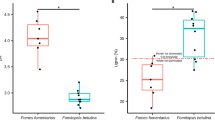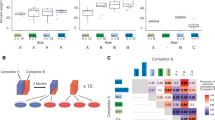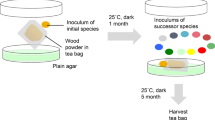Abstract
Many organisms benefit from being pre-adapted to niches shaped by human activity, and have successfully invaded man-made habitats. One such species is the dry rot fungus Serpula lacrymans, which has a wide distribution in buildings in temperate and boreal regions, where it decomposes coniferous construction wood. Comparative genomic analyses and growth experiments using this species and its wild relatives revealed that S. lacrymans evolved a very effective brown rot decay compared to its wild relatives, enabling an extremely rapid decay in buildings under suitable conditions. Adaptations in intracellular transport machineries promoting hyphal growth, and nutrient and water transport may explain why it is has become a successful invader of timber in houses. Further, we demonstrate that S. lacrymans has poor combative ability in our experimental setup, compared to other brown rot fungi. In sheltered indoor conditions, the dry rot fungus may have limited encounters with other wood decay fungi compared to its wild relatives. Overall, our analyses indicate that the dry rot fungus is an ecological specialist with poor combative ability against other fungi.
Similar content being viewed by others
Log in or create a free account to read this content
Gain free access to this article, as well as selected content from this journal and more on nature.com
or
References
Nentwig W (ed) (2008) Biological Invasions. Ecological Studies. Berlin: Springer-Verlag; 193.
Robinson R. In: Genetics of the Norway Rat. International Series of Monographs in Pure and Applied Biology Zoology Division. Oxford: Pergamon Press; 1965;24.
Anderson PK, Cunningham AA, Patel NG, Morales FJ, Epstein PR, Daszak P. Emerging infectious diseases of plants: pathogen pollution, climate change and agrotechnology drivers. Trends Ecol Evol. 2004;19:535–44.
Grunwald NJ, Goss EM, Press CM. Phytophthora ramorum: a pathogen with a remarkably wide host range causing sudden oak death on oaks and ramorum blight on woody ornamentals. Mol Plant Pathol. 2008;9:729–40.
Stukenbrock EH, Bataillon T, Dutheil JY, Hansen TT, Li R, Zala M, et al. The making of a new pathogen: Insights from comparative population genomics of the domesticated wheat pathogen Mycosphaerella graminicola and its wild sister species. Genome Res. London: Academic Press; 2011;21:2157–66.
Kauserud H, Knudsen H, Hogberg N, Skrede I. Evolutionary origin, worldwide dispersal, and population genetics of the dry rot fungus Serpula lacrymans. Fungal Biol Rev. 2012;26:84–93.
Kauserud H, Svegarden IB, Saetre G-P, Knudsen H, Stensrud O, Schmidt O, et al. Asian origin and rapid global spread of the destructive dry rot fungus Serpula lacrymans. Mol Ecol. 2007;16:3350–60.
Jennings DH, Bravery AF (eds) In: Serpula lacrymans: Fundamental Biology and Control Strategies. Hoboken: Wiley-Blackwell; 1991.
Boddy L, Frankland J, van West P (eds) (2007) In: Ecology of Saprotrophic Basidiomycetes.Academic Press, London
Eastwood DC, Floudas D, Binder M, Majcherczyk A, Schneider P, Aerts A, et al. The plant cell wall-decomposing machinery underlies the functional diversity of forest fungi. Science 2011;333:762–5.
Floudas D, Held BW, Riley R, Nagy LG, Koehler G, Ransdell AS, et al. Evolution of novel wood decay mechanisms in Agaricales revealed by the genome sequences of Fistulina hepatica and Cylindrobasidium torrendii. Fungal Genet Biol. 2015;76:78–92.
Arantes V, Goodell B. Current understanding of brown-rot fungal biodegradation mechanisms: a review. In: Schultz TP, Goodell B, Nicholas DD (ed). Deterioration Prot Sustain Mater 2014;1158:3–21.
Riley R, Salamov AA, Brown DW, Nagy LG, Floudas D, Held BW, et al. Extensive sampling of basidiomycete genomes demonstrates inadequacy of the white-rot/brown-rot paradigm for wood decay fungi. Proc Natl Acad Sci USA. 2014;111:9923–8.
Zhang J, Presley GN, Hammel KE, Ryu J-S, Menke JR, Figueroa M, et al. Localizing gene regulation reveals a staggered wood decay mechanism for the brown rot fungus Postia placenta. Proc Natl Acad Sci USA. 2016;113:10968–73.
Presley GN, Schilling JS. Distinct growth and secretome strategies for two taxonomically divergent brown rot fungi. Appl Environ Microbiol 2017;83: e-pub ahead of print, https://doi.org/10.1128/AEM.02987-16.
Floudas D, Binder M, Riley R, Barry K, Blanchette RA, Henrissat B, et al. The Paleozoic origin of enzymatic lignin decomposition reconstructed from 31 fungal genomes. Science. 2012;336:1715–9.
White NA, Dehal PK, Duncan JM, Williams NA, Gartland JS, Palfreyman JW, et al. Molecular analysis of intraspecific variation between building and ‘wild’ isolates of Serpula lacrymans and their relatedness to S. himantioides. Mycol Res. 2001;105:447–52.
Skrede I, Maurice S, Kauserud H. Molecular characterization of sexual diversity in a population of Serpula lacrymans, a tetrapolar basidiomycete. G3 (Bethesda). 2013;3:145–52.
Harmsen L. Taxonomic and cultural studies on brown spored species of the genus Merulius. Friesia. 1960;6:233–77.
Palfreyman JW, Gartland JS, Sturrock CJ, Lester D, White NA, Low GA, et al. The relationship between ‘wild’ and ‘building’ isolates of the dry rot fungus Serpula lacrymans. FEMS Microbiol Lett. 2003;228:281–6.
Skrede I, Engh IB, Binder M, Carlsen T, Kauserud H, Bendiksby M. Evolutionary history of Serpulaceae (Basidiomycota): molecular phylogeny, historical biogeography and evidence for a single transition of nutritional mode. BMC Evol Biol. 2011;11:230.
Kauserud H, Hogberg N, Knudsen H, Elborne SA, Schumacher T. Molecular phylogenetics suggest a North American link between the anthropogenic dry rot fungus Serpula lacrymans and its wild relative S. himantioides. Mol Ecol. 2004;13:3137–46.
Carlsen T, Engh IB, Decock C, Rajchenberg M, Kauserud H. Multiple cryptic species with divergent substrate affinities in the Serpula himantioides species complex. Fungal Biol. 2011;115:54–61.
Zerbino DR, Birney E. Velvet: algorithms for de novo short read assembly using de Bruijn graphs. Genome Res. 2008;18:821–9.
Gnerre S, MacCallum I, Przybylski D, Riberio F, Burton JN, Walker BJ, et al. High-quality draft assemblies of mammalian genomes of massively parallel sequence data. Proc Natl Acad Sci USA. 2011;108:1513–18.
Parra G, Bradnam K, Korf I. CEGMA: a pipeline to accurately annotate core genes in eukaryotic genomes. Bioinformatics. 2007;23:1061–7.
Holt C, Yandell M. MAKER2: an annotation pipeline and genome-database management tool for second-generation genome projects. BMC Bioinformatics. 2011;12:491.
Jones P, Binns D, Chang H-Y, Fraser M, Li W, McAnulla C, et al. InterProScan 5: genome-scale protein function classification. Bioinformatics. 2014;30:1236–40.
Li L, Stoeckert CJJ, Roos DS. OrthoMCL: identification of ortholog groups for eukaryotic genomes. Genome Res. 2003;13:2178–89.
De Bie T, Cristianini N, Demuth JP, Hahn MW. CAFE: a computational tool for the study of gene family evolution. Bioinformatics. 2006;22:1269–71.
Balasundaram SV, Engh IB, Skrede I, Kauserud H. How many DNA markers are needed to reveal cryptic fungal species? Fungal Biol. 2015;119:940–5.
Paradis E, Claude J, Strimmer K. APE: analyses of phylogenetics and evolution in R language. Bioinformatics. 2004;20:289–90.
Loytynoja A. Phylogeny-aware alignment with PRANK. Methods Mol Biol. 2014;1079:155–70.
Fletcher W, Yang Z. The effect of insertions, deletions, and alignment errors on the branch-site test of positive selection. Mol Biol Evol. 2010;27:2257–67.
Yang Z. PAML 4: phylogenetic analysis by maximum likelihood. Mol Biol Evol. 2007;24:1586–91.
Benjamini Y, Krieger AM, Yekutieli D. Adaptive linear step-up procedures that control the false discovery rate. Biometrika. 2006;93:491–507.
Petersen TN, Brunak S, Heijne von G, Nielsen H. SignalP 4.0: discriminating signal peptides from transmembrane regions. Nat Methods. 2011;8:785–6.
Emanuelsson O, Brunak S, Heijne von G, Nielsen H. Locating proteins in the cell using TargetP, SignalP and related tools. Nat Protoc. 2007;2:953–71.
Krogh A, Larsson B, Heijne von G, Sonnhammer EL. Predicting transmembrane protein topology with a hidden Markov model: application to complete genomes. J Mol Biol. 2001;305:567–80.
Hulo N. The PROSITE database. Nucleic Acids Res. 2006;34:D227–D230.
Horton P, Park K-J, Obayashi T, Fujita N, Harada H, Adams-Collier CJ, et al. WoLF PSORT: protein localization predictor. Nucleic Acids Res. 2007;35:W585–7.
Kohler A, Kuo A, Nagy LG, Morin E, Barry KW, Buscot F, et al. Convergent losses of decay mechanisms and rapid turnover of symbiosis genes in mycorrhizal mutualists. Nat Genet. 2015;42:410–5.
Rawlings ND, Waller M, Barrett AJ, Bateman A. MEROPS: the database of proteolytic enzymes, their substrates and inhibitors. Nucleic Acids Res. 2014;42:D503–9.
Lombard V, Golaconda Ramulu H, Drula E, Coutinho PM, Henrissat B. The carbohydrate-active enzymes database (CAZy) in 2013. Nucleic Acids Res. 2014;42:D490–5.
Yin Y, Mao X, Yang J, Chen X, Mao F, Xu Y. dbCAN: a web resource for automated carbohydrate-active enzyme annotation. Nucleic Acids Res. 2012;40:W445–51.
Syed K, Mashele SS. Comparative Analysis of P450 Signature motifs EXXR and CXG in the large and diverse kingdom of fungi: identification of evolutionarily conserved amino acid patterns characteristic of P450 family McCluskey K (ed). PLoS One. 2014;9:e95616–14.
R Development Core Team. R: A Language and Environment for Statistical Computing. Vienna: R Foundation for Statistical Computing; 2008. http://www.R-project.org
Tajima F. The effect of change in population size on DNA polymorphism. Genetics. 1989;123:597–601.
Watkinson SC, Bebber D, Darrah P, Fricker M, Tlalka M, Boddy L. The role of wood decay fungi in the carbon an nitrogen dynamics of the forest floor. In: Gadd GM (ed). Fungi in Biochemical Cycles. Cambridge University Press; 2006. p 1–31.
Berepiki A, Lichius A, Read ND. Actin organization and dynamics in filamentous fungi. Nat Rev Microbiol. 2011;9:876–87.
Grime JP, Pierce S. The evolutionary strategies that shape ecosystems. Hoboken: Wiley-Blackwell; 2012
Kotlaba F. (1992) Nalezy drevomorky domaci - Serpula lacrymans v prirode. Ceska Mycologie.
Bushley KE, Turgeon BG. Phylogenomics reveals subfamilies of fungal nonribosomal peptide synthetases and their evolutionary relationships. BMC Evol Biol. 2010;10:26.
Karlsson M, Durling MB, Choi J, Kosawang C, Lackner G, Tzelepis GD, et al. Insights on the evolution of mycoparasitism from the genome of Clonostachys rosea. Genome Biol Evol. 2015;7:465–80.
Klein C, Kuchler K, Valachovic M. ABC proteins in yeast and fungal pathogens. Essays Biochem. 2011;50:101–19.
Aqueveque P, Anke T, Sterner O. The himanimides, new bioactive compounds from Serpula himantoides (Fr.) Karst. Z Naturforsch C. 2002;57:257–62.
Yoshida M, Igarashi K, Wada M, Kaneko S, Suzuki N, Matsumura H, et al. Characterization of carbohydrate-binding cytochrome b562 from the white-rot fungus Phanerochaete chrysosporium. Appl Environ Microbiol. 2005;71:4548–55.
Sjöström E. (1993) Wood chemistry: fundamentals and applications. London: Academic Press.
Hori C, Ishida T, Igarashi K, Samejima M, Suzuki H, Master E, et al. Analysis of the Phlebiopsis gigantea genome, transcriptome and secretome provides insight into its pioneer colonization strategies of wood. PLoS Genet. 2014;10:e1004759.
Syed K, Shale K, Pagadala NS, Tuszynski J. Systematic identification and evolutionary analysis of catalytically versatile Cytochrome P450 monooxygenase families enriched in model basidiomycete fungi Yu J-H (ed). PLoS One. 2014;9:e86683–18.
Syed K, Yadav JS. P450 monooxygenases (P450ome) of the model white rot fungus Phanerochaete chrysosporium. Crit Rev Microbiol. 2012;38:339–63.
Acknowledgements
We thank Sarah Watkinson for fronting the JGI genome, Ella Thoen for technical help, Anikó Várnai for discussions, and Skui Christmas Tree Plantation for the Abies lasiocarpa wood. S.V.B, J.H., H.K., L.T., and I.S. acknowledge the University of Oslo and Norwegian Research Council (project 221840) for funding. N.H. thanks the Swedish University of Agricultural Sciences and FORMAS (project 2010-1354) for funding. D.C.E., S.C.M., and L.B. thank the UK Natural Environment Research Council, (award NE/K011588/1) for support. Sequencing of SL200 and SHA17-1 was performed by the SNP&SEQ Technology Platform in Uppsala. The facility is part of the National Genomics Infrastructure (NGI) Sweden and Science for Life Laboratory. The SNP&SEQ Platform is also supported bu the Swedish Research Council and the Knut and Alice Wallenberg Foundation. The work conducted by the US Department of Energy Joint Genome Institute, a DOE Office of Science User Facility, was supported by the Office of Science of the US Department of Energy under Contract No. DE-AC02-05CH11231.
Author contributions
I.S., J.H., H.K., D.C.E., N.H., and L.B. conceived and designed the research. L.T, I.S., and J.H. analyzed physiological properties. I.S. and N.H. extracted DNA., K.L., A.A., K.B., and I.V.G. sequenced and analyzed the S. himantioides genome at JGI., S.V.B., M.B.D., J.H., C.P., I.S. and S.C.M. analyzed genomic data. S.V.B., J.H., D.C.E,, H.K. and I.S. wrote the paper and all other authors discussed and modified the paper.
Author information
Authors and Affiliations
Corresponding author
Ethics declarations
Conflict of Interest
The authors declare that they have no conflict of interest.
Electronic supplementary material
Rights and permissions
About this article
Cite this article
Balasundaram, S.V., Hess, J., Durling, M.B. et al. The fungus that came in from the cold: dry rot’s pre-adapted ability to invade buildings. ISME J 12, 791–801 (2018). https://doi.org/10.1038/s41396-017-0006-8
Received:
Accepted:
Published:
Issue date:
DOI: https://doi.org/10.1038/s41396-017-0006-8
This article is cited by
-
The alkynyl-containing compounds from mushrooms and their biological activities
Natural Products and Bioprospecting (2023)
-
Niche differentiation and evolution of the wood decay machinery in the invasive fungus Serpula lacrymans
The ISME Journal (2021)
-
The world’s ten most feared fungi
Fungal Diversity (2018)



